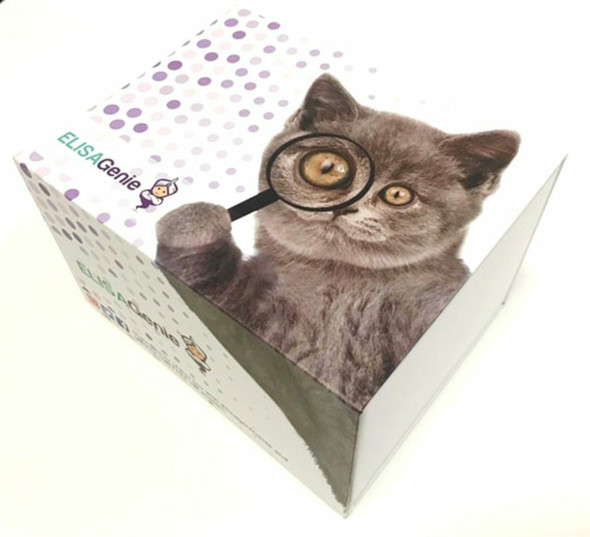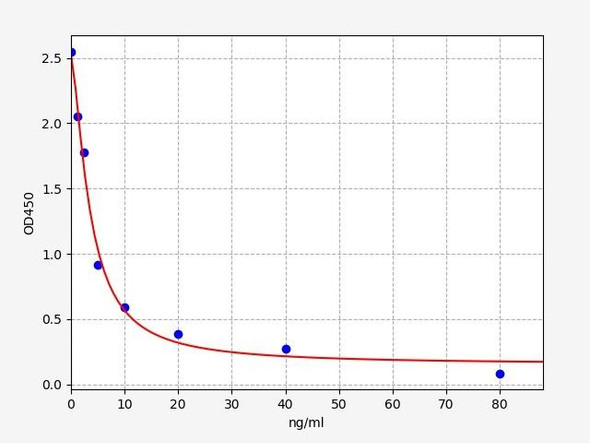TSH (Thyroid-Stimulating Hormone) is a hormone produced by the pituitary gland that regulates the function of the thyroid gland. It stimulates the thyroid to produce and release thyroxine (T4) and triiodothyronine (T3), which are essential for various physiological processes. This mouse TSH ELISA kit is designed to measure the levels of TSH specifically in mouse samples, providing researchers and clinicians with a quantitative tool to assess thyroid function in mice for various experimental or diagnostic purposes.
Description
Mouse TSH ELISA Kit
Key Features
| Save Time | Pre-coated 96 well plate | |
| Quick Start | Kit includes all necessary reagents | |
| Publication Ready | Reproducible and reliable results |
Overview
| Product Name: | Mouse TSH ELISA Kit |
| Product Code: | MOFI01173 |
| Size: | 96 Assays |
| Alias: | TSH, Thyroid Stimulating Hormone |
| Detection Method: | Sandwich ELISA |
| Application: | This immunoassay kit allows for the in vitro quantitative determination of Mouse TSH concentrations in serum plasma and other biological fluids. |
| Sensitivity: | 0.75ng/ml |
| Range: | 1.25-80ng/ml |
| Storage: | 4°C for 6 months |
| Note: | For Research Use Only |
Additional Information
| Recovery | Matrices listed below were spiked with certain level of Mouse TSH and the recovery rates were calculated by comparing the measured value to the expected amount of Mouse TSH in samples.
| ||||||||||||||||||||
| Linearity: | The linearity of the kit was assayed by testing samples spiked with appropriate concentration of Mouse TSH and their serial dilutions. The results were demonstrated by the percentage of calculated concentration to the expected.
| ||||||||||||||||||||
| CV(%) | Intra Assay <8 Inter Assay <10 |
| Recovery | Matrices listed below were spiked with certain level of [ANALYTE] and the recovery rates were calculated by comparing the measured value to the expected amount of [ANALYTE] in samples.
| ||||||||||||||||||||
| Linearity: | The linearity of the kit was assayed by testing samples spiked with appropriate concentration of [ANALYTE] and their serial dilutions. The results were demonstrated by the percentage of calculated concentration to the expected.
|
Kit Components
| Component | Quantity | Storage |
| ELISA Microplate (Dismountable) | 8x12 strips | 4°C for 6 months |
| Lyophilized Standard | 2 | 4°C/ -20°C |
| Sample/Standard Dlution Buffer | 20ml | 4°C |
| Biotin-labeled Antibody (Concentrated) | 120ul | 4°C (Protection from light) |
| Antibody Dilution Buffer | 10ml | 4°C |
| HRP-Streptavidin Conjugate (SABC) | 120ul | 4°C (Protect from light) |
| SABC Dilution Buffer | 10ml | 4°C |
| TMB Substrate | 10ml | 4°C (Protection from light) |
| Stop Solution | 10ml | 4°C |
| Wash Buffer (25X) | 30ml | 4°C |
| Plate Sealer | 5 | - |
Other materials required:
- Microplate reader with 450 nm wavelength filter
- Multichannel Pipette, Pipette, microcentrifuge tubes and disposable pipette tips
- Incubator
- Deionized or distilled water
- Absorbent paper
- Buffer resevoir
Protocol
*Note: Protocols are specific to each batch/lot. For the exact instructions please follow the protocol included in your kit.
Before adding to wells, equilibrate the SABC working solution and TMB substrate for at least 30 min at 37°C. When diluting samples and reagents, they must be mixed completely and evenly. It is recommended to plot a standard curve for each test.
| Step | Procedure |
| 1. | Set standard, test sample and control (zero) wells on the pre-coated plate respectively, and then, record their positions. It is recommended to measure each standard and sample in duplicate. Wash plate 2 times before adding standard, sample and control (zero) wells! |
| 2. | Aliquot 0.1ml standard solutions into the standard wells. |
| 3. | Add 0.1 ml of Sample / Standard dilution buffer into the control (zero) well. |
| 4. | Add 0.1 ml of properly diluted sample ( Human serum, plasma, tissue homogenates and other biological fluids.) into test sample wells. |
| 5. | Seal the plate with a cover and incubate at 37 °C for 90 min. |
| 6. | Remove the cover and discard the plate content, clap the plate on the absorbent filter papers or other absorbent material. Do NOT let the wells completely dry at any time. Wash plate X2. |
| 7. | Add 0.1 ml of Biotin- detection antibody working solution into the above wells (standard, test sample & zero wells). Add the solution at the bottom of each well without touching the side wall. |
| 8. | Seal the plate with a cover and incubate at 37°C for 60 min. |
| 9. | Remove the cover, and wash plate 3 times with Wash buffer. Let wash buffer rest in wells for 1 min between each wash. |
| 10. | Add 0.1 ml of SABC working solution into each well, cover the plate and incubate at 37°C for 30 min. |
| 11. | Remove the cover and wash plate 5 times with Wash buffer, and each time let the wash buffer stay in the wells for 1-2 min. |
| 12. | Add 90 µl of TMB substrate into each well, cover the plate and incubate at 37°C in dark within 10-20 min. (Note: This incubation time is for reference use only, the optimal time should be determined by end user.) And the shades of blue can be seen in the first 3-4 wells (with most concentrated standard solutions), the other wells show no obvious color. |
| 13. | Add 50 µl of Stop solution into each well and mix thoroughly. The color changes into yellow immediately. |
| 14. | Read the O.D. absorbance at 450 nm in a microplate reader immediately after adding the stop solution. |
Sample Preparation
When carrying out an ELISA assay it is important to prepare your samples in order to achieve the best possible results. Below we have a list of procedures for the preparation of samples for different sample types.
| Sample Type | Protocol |
| Serum | If using serum separator tubes, allow samples to clot for 30 minutes at room temperature. Centrifuge for 10 minutes at 1,000x g. Collect the serum fraction and assay promptly or aliquot and store the samples at -80°C. Avoid multiple freeze-thaw cycles. If serum separator tubes are not being used, allow samples to clot overnight at 2-8°C. Centrifuge for 10 minutes at 1,000x g. Remove serum and assay promptly or aliquot and store the samples at -80°C. Avoid multiple freeze-thaw cycles. |
| Plasma | Collect plasma using EDTA or heparin as an anticoagulant. Centrifuge samples at 4°C for 15 mins at 1000 × g within 30 mins of collection. Collect the plasma fraction and assay promptly or aliquot and store the samples at -80°C. Avoid multiple freeze-thaw cycles. Note: Over haemolysed samples are not suitable for use with this kit. |
| Urine & Cerebrospinal Fluid | Collect the urine (mid-stream) in a sterile container, centrifuge for 20 mins at 2000-3000 rpm. Remove supernatant and assay immediately. If any precipitation is detected, repeat the centrifugation step. A similar protocol can be used for cerebrospinal fluid. |
| Cell culture supernatant | Collect the cell culture media by pipette, followed by centrifugation at 4°C for 20 mins at 1500 rpm. Collect the clear supernatant and assay immediately. |
| Cell lysates | Solubilize cells in lysis buffer and allow to sit on ice for 30 minutes. Centrifuge tubes at 14,000 x g for 5 minutes to remove insoluble material. Aliquot the supernatant into a new tube and discard the remaining whole cell extract. Quantify total protein concentration using a total protein assay. Assay immediately or aliquot and store at ≤ -20 °C. |
| Tissue homogenates | The preparation of tissue homogenates will vary depending upon tissue type. Rinse tissue with 1X PBS to remove excess blood & homogenize in 20ml of 1X PBS (including protease inhibitors) and store overnight at ≤ -20°C. Two freeze-thaw cycles are required to break the cell membranes. To further disrupt the cell membranes you can sonicate the samples. Centrifuge homogenates for 5 mins at 5000xg. Remove the supernatant and assay immediately or aliquot and store at -20°C or -80°C. |
| Tissue lysates | Rinse tissue with PBS, cut into 1-2 mm pieces, and homogenize with a tissue homogenizer in PBS. Add an equal volume of RIPA buffer containing protease inhibitors and lyse tissues at room temperature for 30 minutes with gentle agitation. Centrifuge to remove debris. Quantify total protein concentration using a total protein assay. Assay immediately or aliquot and store at ≤ -20 °C |
| Breast Milk | Collect milk samples and centrifuge at 10,000 x g for 60 min at 4°C. Aliquot the supernatant and assay. For long term use, store samples at -80°C. Minimize freeze/thaw cycles. |
TSH Background
Thyroid Stimulating Hormone (TSH)
TSH, or Thyroid-Stimulating Hormone, is a critical hormone secreted by the pituitary gland that regulates the function of the thyroid gland. It plays a key role in maintaining the balance of thyroid hormones in the body, which are essential for metabolism, growth, and development. TSH is composed of an alpha subunit and a beta subunit, with the beta subunit being unique to TSH and enabling its binding to specific receptors on thyroid cells.
TSH Structure
The structure of TSH (Thyroid-Stimulating Hormone) consists of two main components: an alpha subunit and a beta subunit. The alpha subunit is common to other pituitary hormones, including follicle-stimulating hormone (FSH), luteinizing hormone (LH), and human chorionic gonadotropin (hCG). The alpha subunit provides structural stability and allows for interaction with specific receptors on target cells. The beta subunit is unique to TSH and contains a specific amino acid sequence that enables it to bind to TSH receptors located on the surface of thyroid cells
Structure of Mouse TSH Subunit B. Source: Uniprot
TSH Synthesis
TSH is synthesized and released by the pituitary gland in response to signals from the hypothalamus. The hypothalamus releases thyrotropin-releasing hormone (TRH), which stimulates the pituitary gland to produce and release TSH. Ultimately the thyroid stimulating hormine is secreted by the anterior pituitary, and it then acts on the thyroid gland, promoting the synthesis and secretion of thyroxine (T4) and triiodothyronine (T3), the primary thyroid hormones.
Function of Thyroid Stimulating Hormone
The primary function of TSH (Thyroid-Stimulating Hormone) is to regulate the activity of the thyroid gland. TSH acts as a messenger hormone, controlling the production and release of thyroid hormones, namely thyroxine (T4) and triiodothyronine (T3). These thyroid hormones play crucial roles in regulating metabolism, growth, development, and energy balance in the body.
TSH stimulates the thyroid gland to take up iodine, an essential component required for the synthesis of thyroid hormones. It also enhances the production of thyroglobulin, a protein precursor for T4 and T3 synthesis. Through these mechanisms, TSH ensures the continuous and appropriate production of thyroid hormones to maintain optimal physiological functions.
TSH Mechanism of Action and TSH Receptors
The mechanism of action of TSH involves binding to specific TSH receptors on the surface of thyroid cells. TSH receptors are primarily found on the surface of thyroid follicular cells, which are the main functional cells of the thyroid gland.The binding of TSH to TSH receptors activates a G-protein coupled receptor (GPCR) signaling pathway.and triggers a series of intracellular signaling pathways, leading to the activation of genes involved in thyroid hormone synthesis and release.
CLinical SIgnificance-Hyperthyroidism and Hypothyroidism
The effects of abnormal TSH levels are clinically significant. In hyperthyroidism, an overactive thyroid gland, excessive production of thyroid hormones leads to suppressed TSH levels as a result of negative feedback. Low TSH levels indicate an overactive thyroid. Symptoms of hyperthyroidism may include weight loss, rapid heartbeat, anxiety, and increased sensitivity to heat. In hypothyroidism, an underactive thyroid gland, there is insufficient production of thyroid hormones, resulting in elevated TSH levels as the body attempts to stimulate thyroid activity. High TSH levels indicate an underactive thyroid. Symptoms of hypothyroidism may include fatigue, weight gain, cold intolerance, and depression.
Mouse TSH ELISA Kit FAQs
Q: What is the purpose of a Mouse TSH ELISA Kit?
This Mouse TSH ELISA Kit is specifically designed for research purposes to measure the levels of Thyroid-Stimulating Hormone (TSH) in mouse samples. TSH is a crucial hormone involved in regulating thyroid function. By quantifying TSH levels, researchers can assess thyroid activity and investigate its role in various physiological and pathological conditions.
Q: What type of samples can be used with the Mourse TSH ELISA kit?
The Mouse TSH ELISA kit is suitable for biological fluids such as serum samples
Q: Can the Mouse TSH ELISA Kit be used with other sample types apart from mouse?
The Mouse TSH ELISA Kit is specifically designed and validated for mouse samples. While it may be possible to adapt the kit for use with other species or sample types, it is essential to consider the specificity and cross-reactivity of the antibodies included in the kit. For accurate and reliable results, it is recommended to use the kit as intended, with mouse samples.
Q: Where can I find additional technical support or assistance with the Mouse TSH ELISA kit?
For any technical inquiries or assistance regarding the Mouse TSH ELISA kit, you can reach out to our team. They will be available to answer your questions and provide the necessary guidance to ensure a successful experiment.
Related Products
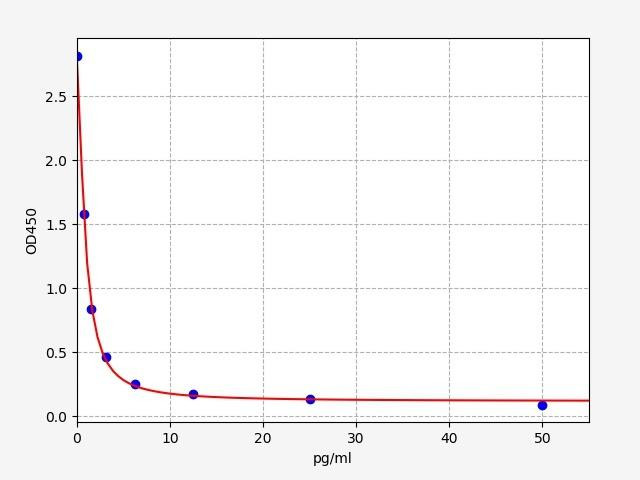
| Mouse T3 ELISA Kit | |
|---|---|
| ELISA TYPE: | Competitive ELISA, Coated with Antigen |
| SENSITIVITY: | 0.469pg/ml |
| RANGE: | 0.781-50pg/ml |
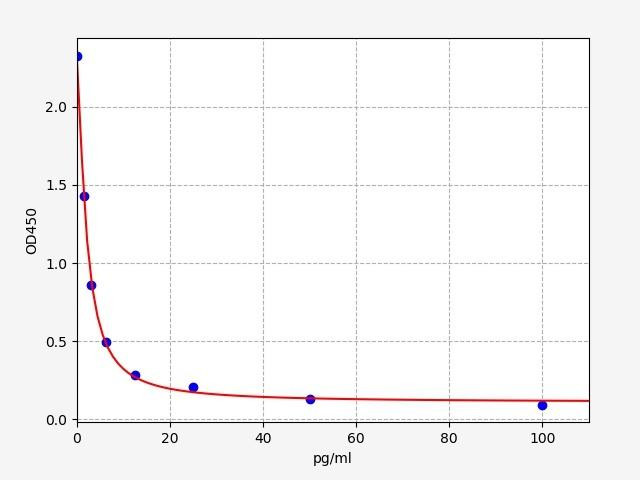
| Mouse T4 ELISA Kit | |
|---|---|
| ELISA TYPE: | Competitive ELISA, Coated with Antigen |
| SENSITIVITY: | 0.938pg/ml |
| RANGE: | 1.563-100pg/ml |
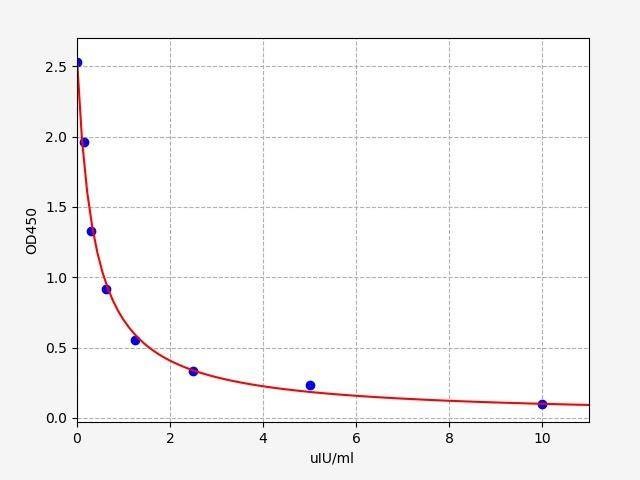
| Mouse Thyrotropin subunit beta / TSHB ELISA Kit | |
|---|---|
| ELISA TYPE: | Competitive ELISA, Coated with Antigen |
| SENSITIVITY: | 0.094uIU/ml |
| RANGE: | 0.156-10uIU/ml |


